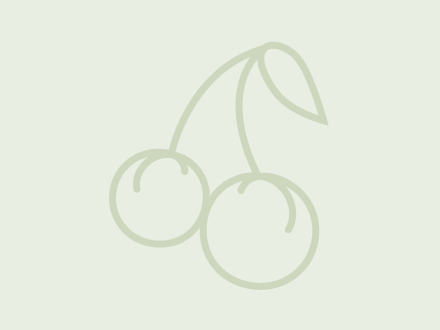An attractive, highly disease-resistant apple, ideal for organic growers.
Stardust™ Cherry on Gisela 12 (Spring 2024)

A self-fertile, white fleshed cherry with good crack resistance. Also known as 13N-07-70 .
This is the first self-fertile, white-fleshed cherry cultivar. A vigorous tree with a spreading habit, Stardust™ blooms about three days after Bing. It produces large, firm, orange-pink fruits with a cream background color. The cherries hold well to the stem and ripen about five days after Rainier (two weeks after Bing). The tree will will need at least two pickings. Stardust™ is self-fertile, making it a great option for the home grower who wants a Rainier style cherry without the need for a pollenizer. Growers report good winter hardiness and suitability for Great Lakes conditions. Stardust™ also shows good resistance to brown rot and bacterial canker.
Stardust™ is a cross of Stella and a breeding selection 2N-63-20 (Bing x Salmo), made by W.D. Lane in 1976 and selected in 1985. It was released in 2002.
The Fruit
Fruit Type
Category: Cherry
Subcategory:
Crack-Resistant, Sweet, Self-Fertile
Fruit Uses & Storage
Uses: fresh eating, jam, baking
Storage duration: less than one month (approximate, depending on storage conditions)
Fruit Appearance
Skin color: orange
Flesh color: white
Fruit Origins
Parentage: 2N-63-20 (Bing x Salmo) x Stella
Origin: Summerland, British Columbia, Canada
Introduced in: 2002
Introduced by: W.D. Lane; Pacific Agri-Food Research Center
The Environment
Calendar & Geography
USDA zones: 5 - 8
Chill hours: 800
Ripening date: Jul 04 (approximate, in New York State) + 14 days after Bing
Tree Height & Spacing
glossary
Rootstock: Gisela 12 Rootstock
Rootstock size class: Half-Standard (60% of Standard)
Tree spacing: See details
Good for wildlife planting? N
Diseases & Pests
glossary
Bacterial Canker of Stone Fruit: Resistant
Brown Rot, Blossom Blight, Fruit Rot: Resistant
Pollination
Pollination Factors
glossary
Bloom group:
Is it self-fertile? Y
Is it fertile? Y
Ploidy: Diploid
Rootstock size class:
Half-Standard (60% of Standard)
Pollination Partners
Sweet cherries are not part of our search tool given various complexities. Please see our Pollenizer Search to run other queries and read how the application uses various factors. Also read more about fruit tree pollination.
Featured Products
A few things we're loving right now...
A full-flavored, freestone white peach.
One of America's oldest apples, good for storage, baking, and cider.
A widely-grown, large, yellow-fleshed nectarine.












